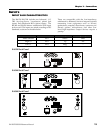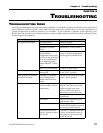
Connections: Chapter 2
20 RA150/300/500 Reference Manual
THE IMPORTANCE OF SPEAKER
POLARITY
The speaker cone’s motion should mimic the
instrument it’s reproducing. For example, a kick
drum pushes air toward you on the initial transient,
so a speaker reproducing a kick drum should have
its cone push air toward you. If the polarity is
reversed, the cone will suck air away from you.
Even though the same amount of air is moved in
either case, many listeners report superior sound
with proper polarity as opposed to reversed
polarity.
An additional problem occurs if the polarity of one
speaker is reversed with respect to the other. This
can cause phase-related problems such as thin bass,
poor stereo imaging and frequency response
anomalies.
With the RA150/300/500, polarity is a function of
correctly hooking up the output cables. Usually, for
proper polarity, the tip of the output phone plug or
the red terminal of the output connector must
connect to the speaker’s positive (+) terminal. This
will ensure that polarity from the RA150/300/500
input to speaker cone motion will be consistent.
Check your speakers' polarity, however, because
not all brands follow this wiring convention.
Please note that polarity reversal can occur in
devices (such as mixers or effects units) “upstream”
of the RA150/300/500. To test for proper speaker
and system polarity, see page 22.
OUTPUT CONNECTIONS FOR
BRIDGED OPERATION
Instead of using the RA150/300/500 as a stereo 2-
channel amplifier, it is possible to use it as a mono
amplifier with twice the power. This uses both
sides of the amplifier in a push-pull configuration,
so the speaker must be wired to the amp differently.
However, note that the minimum load impedance is
8 ohms, instead of the 4 ohms in stereo operation.
To connect a speaker in bridged mono
mode:
Following the instructions on the previous page for
binding post or crimp-on connection, connect the
"+" wire to the red binding post for the Channel
1/Left and the "-" wire to the red binding post for
Channel 2/Right.
You may use a dual banana plug in this situation. If
present, remove the protective caps from the top of
the binding posts for the two red terminals. Plug
the banana connector into the two center red
terminals with the ridged/GND side on Channel
2/Right.
The single input is connected ONLY to the Channel
1/Left input jack, and the stereo/mono switch
under the right input connector should be set to
BRIDGED MONO. Don't plug any input into the
Channel 2/Right input jack, and leave the Channel
2 volume control all the way down.
Should you use bridged mode?
In a typical PA system with two speakers, in most
cases you'll be better off running the
RA150/300/500 in stereo mode, because most
speakers are 8 ohms and if they were wired in
parallel the total load would be 4 ohms, too low for
bridged mode. In any case, the total system volume
doesn't rise if you were to connect 2 speakers to a
single 500-watt amp instead of to two 250-watt
amps.
But if you are connecting to a single speaker (such
as a subwoofer) in a biamped or triamped setup,
bridged mono mode will give you the chest-
thumping headroom you need.


















